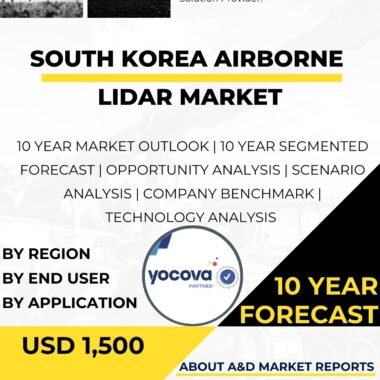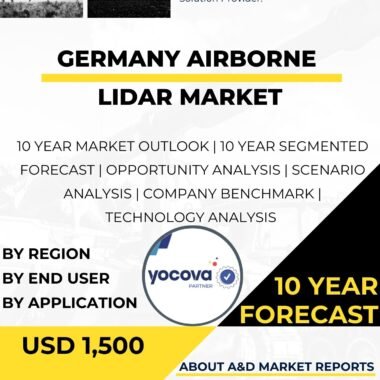Description
Brazil Airborne LiDAR Market
The Brazil Airborne LiDAR Market is a rapidly growing and crucial sector within the country’s geospatial and surveying industry, focused on the utilization of Light Detection and Ranging (LiDAR) technology from airborne platforms to gather precise and high-resolution topographic data. As Brazil seeks to improve its infrastructure development, environmental monitoring, and disaster management, the demand for airborne LiDAR systems has surged, positioning the country as a significant player in the global Airborne LiDAR Market.
The Brazil Airborne LiDAR Market encompasses a diverse range of applications, each contributing to the country’s overall socio-economic development and environmental sustainability. One of the primary applications is in the field of infrastructure development. Airborne LiDAR is utilized to survey and map vast areas quickly and accurately, providing detailed 3D terrain models, digital elevation models (DEMs), and digital surface models (DSMs). This data is crucial for infrastructure planning, such as road construction, urban development, and land-use planning, enabling more informed and efficient decision-making processes.
Moreover, the market addresses the role of airborne LiDAR in environmental monitoring and natural resource management. Airborne LiDAR data can be used to assess forest canopy height, monitor deforestation, estimate biomass, and conduct habitat mapping for wildlife conservation efforts. Additionally, airborne LiDAR is instrumental in monitoring coastal erosion, water bodies, and wetlands, facilitating the management and preservation of Brazil’s diverse ecosystems.
The Brazil Airborne LiDAR Market also focuses on disaster management and emergency response applications. Airborne LiDAR data is valuable for flood modeling, landslide susceptibility mapping, and disaster risk assessment, providing critical information to respond effectively to natural disasters and mitigate their impact on communities and infrastructure.
The integration of advanced LiDAR technologies has been instrumental in the development of airborne LiDAR systems in Brazil. Research and development efforts concentrate on improving LiDAR sensor capabilities, data processing algorithms, and automation of data collection and analysis. The development of airborne LiDAR systems often involves collaboration between surveying companies, research institutions, and government agencies, ensuring that the systems meet the stringent requirements of Brazil’s diverse and complex terrain.
The export-oriented focus of the Brazil Airborne LiDAR Market has expanded its global presence. Brazilian airborne LiDAR technology and surveying services have gained international recognition for their accuracy, reliability, and efficiency. Brazil places a high priority on responsible data collection and data privacy, ensuring that airborne LiDAR data is used responsibly and in accordance with privacy regulations.
Brazil’s geospatial industry actively engages in research and development (R&D) activities to advance airborne LiDAR technology continuously. Collaboration between surveying companies, research institutions, and the Brazilian government fosters innovation and technological advancements in the market. This synergy ensures that airborne LiDAR systems produced meet the stringent requirements of various sectors, including infrastructure, environment, and disaster management.
Moreover, the market benefits from Brazil’s expertise in geospatial science, remote sensing, and surveying technologies. Brazilian companies have been at the forefront of developing state-of-the-art airborne LiDAR systems and providing specialized LiDAR surveying services, addressing the unique challenges of gathering accurate and comprehensive topographic data.
Despite the impressive progress and benefits of airborne LiDAR systems, challenges remain in the market. One of the primary challenges is the cost associated with airborne LiDAR data collection and analysis. While LiDAR technology has become more accessible and cost-effective over the years, airborne LiDAR data collection still requires significant investment, particularly for large-scale surveying projects.
Moreover, the market faces challenges related to data processing and analysis. Handling large volumes of LiDAR data and converting it into actionable information requires sophisticated software tools and skilled data analysts. Ensuring the availability of trained personnel and advanced data processing algorithms is essential to maximizing the value of airborne LiDAR data.
Looking ahead, the future of the Brazil Airborne LiDAR Market remains promising, driven by continuous research and development efforts, international collaborations, and the increasing demand for precise and reliable topographic data in various sectors. As Brazil’s geospatial needs evolve, the country’s dedication to innovation and technological advancements will solidify its position as a leading player in the global Airborne LiDAR Market. The market’s ability to provide efficient and effective airborne LiDAR systems while addressing emerging challenges will enhance the nation’s infrastructure development, environmental conservation, and disaster management efforts, contributing to sustainable and resilient growth.




